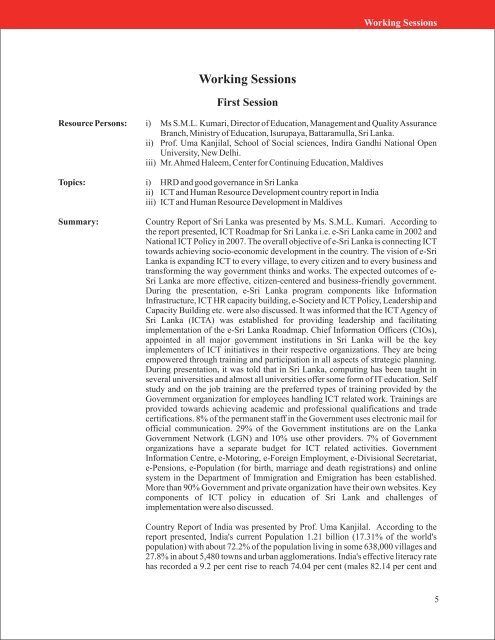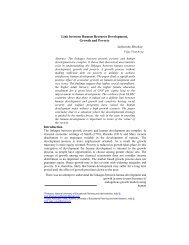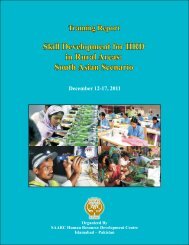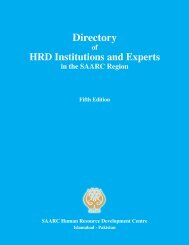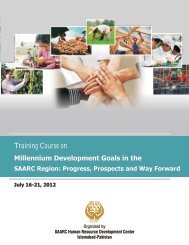Here - SAARC Human Resource Development Centre
Here - SAARC Human Resource Development Centre
Here - SAARC Human Resource Development Centre
- No tags were found...
You also want an ePaper? Increase the reach of your titles
YUMPU automatically turns print PDFs into web optimized ePapers that Google loves.
Working SessionsWorking SessionsFirst Session<strong>Resource</strong> Persons: i) Ms S.M.L. Kumari, Director of Education, Management and Quality AssuranceBranch, Ministry of Education, Isurupaya, Battaramulla, Sri Lanka.ii) Prof. Uma Kanjilal, School of Social sciences, Indira Gandhi National OpenUniversity, New Delhi.iii) Mr. Ahmed Haleem, Center for Continuing Education, MaldivesTopics: i) HRD and good governance in Sri Lankaii) ICT and <strong>Human</strong> <strong>Resource</strong> <strong>Development</strong> country report in Indiaiii) ICT and <strong>Human</strong> <strong>Resource</strong> <strong>Development</strong> in MaldivesSummary:Country Report of Sri Lanka was presented by Ms. S.M.L. Kumari. According tothe report presented, ICT Roadmap for Sri Lanka i.e. e-Sri Lanka came in 2002 andNational ICT Policy in 2007. The overall objective of e-Sri Lanka is connecting ICTtowards achieving socio-economic development in the country. The vision of e-SriLanka is expanding ICT to every village, to every citizen and to every business andtransforming the way government thinks and works. The expected outcomes of e-Sri Lanka are more effective, citizen-centered and business-friendly government.During the presentation, e-Sri Lanka program components like InformationInfrastructure, ICT HR capacity building, e-Society and ICT Policy, Leadership andCapacity Building etc. were also discussed. It was informed that the ICT Agency ofSri Lanka (ICTA) was established for providing leadership and facilitatingimplementation of the e-Sri Lanka Roadmap. Chief Information Officers (CIOs),appointed in all major government institutions in Sri Lanka will be the keyimplementers of ICT initiatives in their respective organizations. They are beingempowered through training and participation in all aspects of strategic planning.During presentation, it was told that in Sri Lanka, computing has been taught inseveral universities and almost all universities offer some form of IT education. Selfstudy and on the job training are the preferred types of training provided by theGovernment organization for employees handling ICT related work. Trainings areprovided towards achieving academic and professional qualifications and tradecertifications. 8% of the permanent staff in the Government uses electronic mail forofficial communication. 29% of the Government institutions are on the LankaGovernment Network (LGN) and 10% use other providers. 7% of Governmentorganizations have a separate budget for ICT related activities. GovernmentInformation <strong>Centre</strong>, e-Motoring, e-Foreign Employment, e-Divisional Secretariat,e-Pensions, e-Population (for birth, marriage and death registrations) and onlinesystem in the Department of Immigration and Emigration has been established.More than 90% Government and private organization have their own websites. Keycomponents of ICT policy in education of Sri Lank and challenges ofimplementation were also discussed.Country Report of India was presented by Prof. Uma Kanjilal. According to thereport presented, India's current Population 1.21 billion (17.31% of the world'spopulation) with about 72.2% of the population living in some 638,000 villages and27.8% in about 5,480 towns and urban agglomerations. India's effective literacy ratehas recorded a 9.2 per cent rise to reach 74.04 per cent (males 82.14 per cent and5


